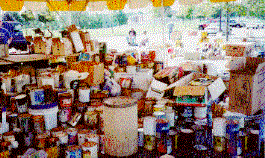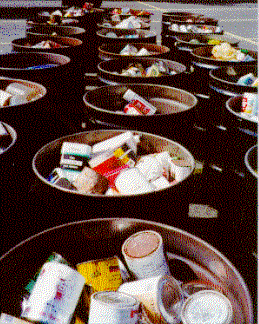by Larry Gindoff, Solid Waste Coordinator, Morris County, NJ, June 1993
As Morris County’s household hazardous waste (“HHW’) coordinator since 1987, I ran eight uneventful HHW disposal days prior to the one that occurred on a very hot Saturday in June of 1993. This disposal day, which taxed the ability of the workers and the patience of the residents, is the subject of this article. My description will illustrate several potential problems that must be considered when designing a safe and successful HHW program.
This day started like any other HHW disposal day. I arrived at the Morris County Road Department Garage at 6:15 a.m. and at 6:30 a.m. a caravan of trucks belonging to Wade Salvage of Atco, N.J., started rolling onto the site. By 6:45 a.m. the site was bristling with action.
It was cool, crisp morning but the crystal clear skies and the knot in my stomach made me realize it was going to be a scorcher. Although we stopped requiring pre-registration, I knew from the inquiries I had received that this was going to be Morris County’s busiest disposal day to date. My instincts were correct because at 7:00 a.m. the first resident arrived. I told her we were scheduled to open at 9:00a.m. but she insisted on waiting to “beat the crowd.” By 8:00 a.m. there were approximately 150 people like her there to beat the crowd.
The Road Department employees who were there only to setup the site worked feverishly to get all of the cars off Hanover Avenue, a busy County Road, and onto the garage site. Luckily we redesigned the queuing pattern from previous years to allow for approximately 75 cars to line up on-site. In the past the site was laid out for approximately 25 cars to queue on-site but due to predicted demand, we redesigned the layout but it was obviously not enough.
To accommodate the remaining 75 cars waiting for us to open, we established a second line on site much like the dreaded lines you encounter at a DMV inspection station. I knew people weren’t going to be happy when we started to run a program like the DMV and I was right. We opened just after 8:00 a.m. and the hazardous waste came pouring in.
Wade’s workers quickly got busy emptying out the trunks of the participants. Initially processing two cars simultaneously, then four then six. We were accepting waste at record rates. By no fault of Wade Salvage, the lines just got longer. One problem was, the site was so congested with cars lining up, and eventually with paint cans unloaded but not yet consolidated into drums, there was no room for cars with one or two items to pass cars that were no completely unloaded. This resulted in choke points, longer lines and angry people.
 Eventually the line could no longer be contained on-site and it spilled onto Hanover Avenue. The local police were immediately called to control traffic on this road. One line got longer until it reached a major intersection one quarter mile down the road. At this point the police closed the line and would not let any other cars on it.
Eventually the line could no longer be contained on-site and it spilled onto Hanover Avenue. The local police were immediately called to control traffic on this road. One line got longer until it reached a major intersection one quarter mile down the road. At this point the police closed the line and would not let any other cars on it.
To complicate matters, resourceful residents parked on a side street and walked their hazardous waste down to the collection point. Before I knew it, I had a procession of people lugging down multiple cans of paint, pesticides and chemicals to the processing area. Although, we quickly stopped these walk-ons, the damage was done. We had more angry participants and unknown material deposited.
 At the worst, people had to wait an hour to get unloaded but by 11:00 a.m. we got into a good flow of unloading cars and the wait was down to 15 to 20 minutes By 1:00 p.m. there were no more cars lined up off-site. By 2:00 p.m. closing time there were just a few cars to process. We survived Morris County’s busiest HHW disposal day with just over 1,000 participants. The only thing left to do was to pack the vast amount of waste left unprocessed in piles. I knew there would be no more surprises. I relaxed for a moment and at 4:00 p.m. ate my first food for the day, a cold five hour old cheese steak sandwich. It was getting late and I was eager to go home. I was ready to go into work Monday and explain why we had such long lines and how we were going to change it for the future. After all, many people in a rage screamed, “Who’s in charge here and where do I complain?”
At the worst, people had to wait an hour to get unloaded but by 11:00 a.m. we got into a good flow of unloading cars and the wait was down to 15 to 20 minutes By 1:00 p.m. there were no more cars lined up off-site. By 2:00 p.m. closing time there were just a few cars to process. We survived Morris County’s busiest HHW disposal day with just over 1,000 participants. The only thing left to do was to pack the vast amount of waste left unprocessed in piles. I knew there would be no more surprises. I relaxed for a moment and at 4:00 p.m. ate my first food for the day, a cold five hour old cheese steak sandwich. It was getting late and I was eager to go home. I was ready to go into work Monday and explain why we had such long lines and how we were going to change it for the future. After all, many people in a rage screamed, “Who’s in charge here and where do I complain?”
It was 10:00 p.m. when the bad news came. The chief chemist alerted me to the fact that they had discovered a jar of crystallized picric acid which is very unstable and explosive. He suggested that for safety’s sake we notify the County’s emergency management unit and bomb squad; so I did.
Within five minutes a jeep with flashing lights arrived on-site from the local fire department asking what was going on. The chemist explained the situation to him and he communicated over the radio with other officials. All I was thinking was that I wished this guy would shut off his flashing lights so as not to draw any additional bad publicity to my HHW program.
Before I realized what happened, this firefighter took control of the situation and ordered the evacuation of the site bringing all work to a halt. Eleven homes within a quarter mile of the garage were evacuated. If this wasn’t bad enough, it was decided to close Hanover Avenue for a quarter mile on each side of the garage. While the emergency personnel decided what to do with the bottle of picric acid the size of a small jar of spaghetti sauce, more and more equipment and personnel arrived on the scene. Soon to come were several ambulances, several fire trucks, the Mayor of the Township, the County Administrator, a County Freeholder and scores of emergency personnel including volunteer firefighters and paramedics.
At 4:00 a.m., after several hours of preparation, the bomb squad signaled everyone by blowing a horn that it was about to detonate the picric acid. A big bang ensued, no one was hurt and the episode seemed over. The emergency personnel packed up their equipment, and left the scene. There was still the work of loading all the filled drums onto the trucks before the job was done. Wade reassembled its work force and went back to work.
By 6:00 a.m. Sunday morning all the drums were loaded, counted, manifested and the caravan started to leave the sight. At 6:15 a.m., exactly 24 hours after I had first arrived, I started my car and drove home. This was like no other HHW disposal day.
I have told you this story of a day in the life of HHW management so both the HHW coordinator and disposal company can learn from my experience. Following that June 1993 program, the County relocated its HHW disposal days to the parking lot of its Fire and Police Training Academy. This site had much more room to operate and was utilized for two disposal days in the Fall of 1993. Both disposal days operated like all the other disposal days I had conducted except that one big event on that hot June day.
——————————————————————————–
Name: Daniel Capelle
Affliation: Onyx Environmental Services
EMail: dcapelle@onyxes.com
Date: 1/13/00
Comments
Onyx Environmental Service (OES), with offices located throughout the East Coast and centered in Flanders, NJ most likely could have handled the picric acid management as safely and with less cost and less down-time for Morris County. Along with conducting several HHW events annually, OES has a highly-trained and well-equipped Reactives Chemical Group (RCG). The RCG utilizes a specially designed Remote Opener, BATF- issue Fragmentation Gear (ppe) and other equipment on a weekly basis for just this sort of material managment. An appropriate solvent (in this case water) is added to the container once opened. The material is then available for standard handling, transportation and disposal as a hazard class 4.1 (Flammable Solid) material. Detonation as a management technique can cause a lot of headaches and usually is not the best option. Sorry for the Company pitch…I couldn’t resist…I coodrinate the RCG of the Midwest. As a side note, I too have worked several long hours on HHW events; however, your 24-hour tale has me beat…my longest to date is a 20-hour day.
——————————————————————————–
Name: Greg Boe
Affliation: Scott County (MN) Environmental Health
EMail: gboe@co.scott.mn.us
Date: 8/5/99
Comments
I feel your pain!! We too had one collection day worse than all the rest, with nearly 1000 cars. Our saving grace was that our collection was held at a County Highway Garage out in the country, so the line of cars spilled out onto a 2-lane country highway rather than a busy city street. It gets to be a long day…my back and feet hurt for days!!! We got a few angry calls on Monday, but it actually worked to our advantage, as it clearly showed our citizens the need for a permanent HHW Facility open multiple times per month rather than the one-day collections and ever-increasing lines of cars!! GOOD LUCK!!!!
